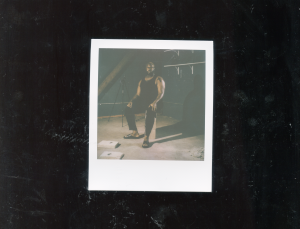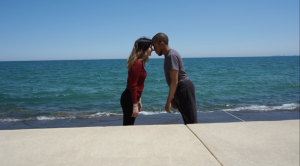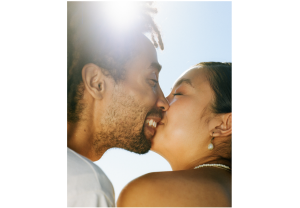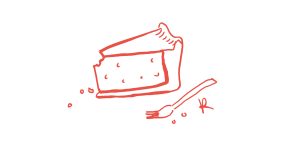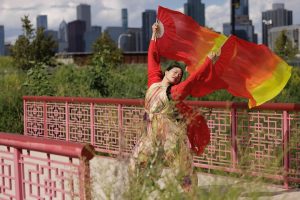My first encounter with photographer Matt Austin was over two years ago during my time as a student in a photography class where he was the teacher’s assistant. Since the days of me trying to catch sneak peeks of his work in the photo labs at Columbia College, his work has evolved into something that is less about the photo as a static object and more about how photography functions as a tool within something larger–his life experiences and the experiences of those around him. What we can gain from his practice is not only an appreciation for the moments in life that we often take for granted, but also the opportunity to tap into our own uncertainties and fears of meaningful interactions with unfamiliar people and places through his treks across cities, countries and seas. His most recent work invites you to tag along as he creates a biography in motion. In light of his solo exhibition, Talking With Fear About Dying Tomorrow, which opens on March 4, 2011 at Johalla Projects, I sat down with Matt to find out more about the mental and physical journeys that led him to this moment in his career.

Tempestt Hazel: Can you tell me about your background? How you got into photography?
Matt Austin: As far as my education, I started at St. Ambrose University in Davenport, Iowa, to go to school for mathematics education. After a year of doing that I was dissatisfied enough with my life that I didn’t care where I went, as long as it wasn’t in Iowa. It wasn’t even that Columbia [College] was of any interest to me, it was just that Columbia was not in Davenport, Iowa–that was the only interest in going to Columbia. That, and my brother was going there and we had recently become friends, I guess.
TH: You and your brother?
MA: Yeah.
TH: As opposed to being enemies?
MA: Right. [Jeff and I] hated each other for the majority of being alive. I think we’re at about fifty percent now in terms of years being friends versus being enemies.
TH: Did you guys end up bonding over creative things? I mean, what made you become friends?
MA: Our forced interaction came because of two things. [First] our parents getting divorced in high school, which resulted in me having to drive Jeff around a lot to his friends’ houses and going from Mom’s house to Dad’s house and Dad’s house to Mom’s house. I would be the driver, so lots of forced car rides together. You know, I’d still say we weren’t even friends at that point–we starting having to tolerate each other because we had to spend so much time together. [And second,] what kicked off the friendship is basically my brother got in trouble with my mom for something that he wrote in his journal that she read, so he was sent to Iowa to spend time with me as a punishment.

TH: And it turned out to be a good thing?
MA: Kind of. For the first, I don’t know, three days, I’m pretty sure my brother didn’t talk to me or any of my friends. But then one day he had a camera on him and I asked, “Why do you have a camera?” And he said his friend gave him a camera because she liked photography. I asked him what he takes pictures of and he said that he just walks around and takes pictures of whatever. I thought that was really stupid. But then, one time we walked around and drove around parts of Davenport and he would stop to take pictures and he showed me how the camera worked.
TH: What kind of camera was it?
MA: I think it was a Minolta something–a really eighties camera, 35mm, half broken camera. He got it for about $80 from his friend.
TH: Was that a trigger? Was that your first time picking up a camera?
MA: Well, yeah, and then I’d been playing a lot of poker and I was also tutoring calculus for a long time at [St. Ambrose] so, I had accumulated this money because there’s nothing to do in Davenport so you don’t spend money on really anything–especially as an 18 year old. My friend Phil, at the time, was working at Best Buy so he could get me a deal on a camera. I got the most basic Canon thing–total consumer film camera. I just got it to do whatever. I’d say that was when my brother and I actually started talking regularly. I would show him random pictures that I would take and he would show me random pictures that he would take–just Walgreens-developed four by sixes.

Then when I moved back to Illinois that summer, when I actually thought I would be going back to St. Ambrose to give it one more year, was when I was still experiencing the divorce situation of living. So, the car rides continued with me and my brother and we would take advantage of the similar interests. When we would stay at my mom’s we would go out at 3am and photograph at night and become a team with that. Some time that summer my friend Mike let me borrow his digital camera and I had a lot of fun with that.
TH: What was the conversation between your photographs and your brother’s photographs?
MA: Well, he had been doing it way more than me. While I was doing academic mathematics and physics–he was doing more creative things like music, drawing, painting, and taking photographs. I would say that almost all the time I was just asking him which ones were good because I didn’t know. [laughs] I had a general sense of what I liked but I wasn’t really sure why or what made it good or bad.
TH: So, you started at Columbia in graphic design. When did the switch to photography happen?
MA: Honestly, I think it was day two. My only friend at Columbia was Trevor McNaughton–he was going to Columbia for photography while I [didn’t] really know. I met him over the internet, based on our enrollment in Columbia, so we’d known each other for those two days. My mom is good at graphic design, so I think I started as a Graphic Design major because you have to pick something. I didn’t know, and I’m not sure I really cared because I didn’t know what I was going there for aside from getting away from Iowa.

I went to my first day of school and I think it was mostly [general education] classes that I went to. I hung out with Trev that night and he [asked if I was] going to the photography orientation in the morning. I said no because I was enrolled as graphic design and my orientation was on Friday. He told me to skip that and go to the photography one, so I did that and it was great. Justin Schmitz was the main speaker that shared his work. Bill Frederking gave the tour. I was super impressed and inspired by the people who showed work, so I ended up saying, “Screw the graphic design thing–I’m just going to do this.” It was a pretty quick decision to switch it. Now, years later, [I know] each of these people personally.
TH: How would you describe the photography you do? What is the theme that strings itself throughout your work?
MA: If you had to string it all together, I’d say my photography is basically a consequence of my lifestyle. It’s been a while since I’ve actually said, “I’m going to do this project about this.” I think the last time I did that was probably sophomore year of college.
TH: Really? How did you function in school without that approach?
MA: It was a rollercoaster.

TH: Were your professors critical of that approach?
MA: Yes. It was great. It was a lot of fun actually. There was a point at Columbia where I refused to do any photography because I got to this point around the time of my mom’s boyfriend being diagnosed with cancer where I just thought that my photography doesn’t functionally do anything, so I just felt like I was wasting my time and would rather be spending my time doing something of utility and actually know that I am benefiting somebody.
I ended up collaborating with Andrew McComb in Myra Greene’s Senior Thesis class. When we went around the room and each person had to share what their plans for the class were, both of us expressed how we didn’t want to do photography anymore and we just wanted to help people out with different things. My original idea was that I was just going to cook for people with no documentation because I found that any time I would try and document the dinner or the meal that it would inhibit what I was actually doing and make the experience less real or less significant. Andrew’s original idea was to just pick up garbage in the alley and put it in the garbage, wave to his neighbors and not document it at all.
What we ended up doing is coming together, and Myra eventually said that we could do these kind of performances inside the classroom. So, we would basically—instead of composing a photograph, we would compose a situation. To summarize what we did: we designed situations that guided people to be nice to each other.

TH: Can you give an example?
MA: One of our first performances was I spent $25 on food and Andrew spent $25 on food, and we were careful about what food we brought in. We brought in food that needed some kind of preparation–cheese and crackers, peanut butter and jelly, tea, water and sugar, chips and salsa. Then we said, “We know you guys are hungry and tired so we bought you $50 worth of food. And as we’re doing this favor for you, could you do one favor for us? We just ask that in this time together that we sit and eat you can’t do anything for yourself.” So, if you wanted a chip dipped, you’d need to ask somebody to dip it for you. And if you wanted your tea prepared, you needed to ask someone to do it for you and let them know how you want it done. You have to share your preference. It was hilarious. Most just ended up laughing at how ridiculous the situation was but it worked in our eyes in the sense that people who never talked to each other were talking to each other about how much peanut butter and how much jelly they liked on their sandwich.
TH: The things you never think about.
MA: Yeah, things they wouldn’t know about each other. It was funny because of the fact that you were essentially disabled from helping yourself–it was this funny situation of helplessness.
TH: I would be uncomfortable.
MA: That was the other thing. If you wanted food you had to get over the fact that someone was handling it before you put it in your mouth.

TH: See, I’m fine with that, but the asking is the part I would be uncomfortable with.
MA: Yeah. But we believed that to be an important discomfort, addressing your self-consciousness. [For] the other one that ended up being our final project we redesigned the classroom where we got all the chairs pushed to the side and the tables pushed to the side and we shut the blinds and we got popcorn and got blankets. Actually I’m not sure if the popcorn part ever happened, but I really wanted it to. We laid the blankets on the ground, and turned the lights off. Andrew and I sat in chairs at the head of everybody laying down on the ground and basically recreated kindergarten nap time but for seniors in college.
We also laid out every journal we’d ever written at our feet and anyone who wanted to could pick out a journal and an entry at random and have us read it aloud to the class. So, it was an intense, personal story time, which was interesting. It was weird how it functioned because everyone was instantly relating and interested in the juicy stuff. They would be bored by our lists of developers and films that we would need to get down, but if it was a back-stabbing poem to an ex-girlfriend then they would love that. It became this weird form of entertainment, but really humanizing because people really wanted to share that experience.
TH: Was it awkward for you?
MA: Yes.
TH: What did you learn about yourself by working with a new or different practice?
MA: I’d say I learned that there’s not just one way of connecting with people. Just because I got a photography degree doesn’t mean that the only way I can connect with people is through photographs. The performance taught me that you don’t need to just connect with people through art. I feel like this is a new revelation that I’ve come to in the past six months or so through traveling, teaching, getting lunches with my mom or dad. It’s all now part of my art practice. It’s all the same idea of looking at something and thinking, “How can I learn more from this?” I think [those performances] were the start of it, me realizing I can affect people and learn more about myself through doing something that I haven’t studied before. It doesn’t need to be such a set structure. It doesn’t have to be 15 to 20 photographs with an artist statement. It could be anything.
This is Part One of the interview with Matt Austin. Stay tuned for Part Two the first week of March.
Save the date for his ACRE Exhibition, Talking With Fear About Dying Tomorrow at Johalla Projects on March 4, 2011. Prior to the exhibition, Matt will be having a print sale. Learn more HERE.
In the meantime, find out more about Matt Austin‘s work by visiting www.mattaustinphoto.com.
